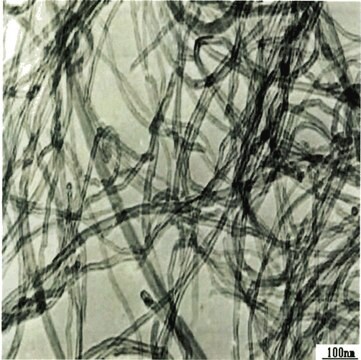Key Documents
406074
Carbon nanotube, multi-walled
powdered cylinder cores, 20-30% MWCNT basis, O.D. × L 7-12 nm × 0.5-10 μm, avg. no. of layers, 5 ‑ 20
Synonim(y):
MWCNT, MWNT, Multiwall carbon nanotube
About This Item
Polecane produkty
Poziom jakości
Próba
20-30% MWCNT basis
Postać
powder
Właściwości
avg. no. of layers 5 ‑ 20
skład
carbon content, >99% TGA
śr. zewn. × dł.
7-12 nm × 0.5-10 μm
śr. rozm. cząst.
−270 mesh
<53 μm
mp
3652-3697 °C (lit.)
gęstość
~2.1 g/mL at 25 °C (lit.)
Szukasz podobnych produktów? Odwiedź Przewodnik dotyczący porównywania produktów
Opis ogólny
Zastosowanie
Postać fizyczna
Uwaga dotycząca przygotowania
Inne uwagi
Kod klasy składowania
11 - Combustible Solids
Klasa zagrożenia wodnego (WGK)
WGK 3
Temperatura zapłonu (°F)
Not applicable
Temperatura zapłonu (°C)
Not applicable
Środki ochrony indywidualnej
dust mask type N95 (US), Eyeshields, Gloves
Wybierz jedną z najnowszych wersji:
Masz już ten produkt?
Dokumenty związane z niedawno zakupionymi produktami zostały zamieszczone w Bibliotece dokumentów.
Klienci oglądali również te produkty
Produkty
Carbon nanotubes (CNTs) have received much attention since their discovery in 1991 by Sumio lijima1 due to their excellent mechanical, electrical, and optical properties.
Nanorurki węglowe (CNT) cieszą się dużym zainteresowaniem od czasu ich odkrycia w 1991 roku przez Sumio Lijima1 ze względu na ich doskonałe właściwości mechaniczne, elektryczne i optyczne.
A nanocomposite is typically defined as a mixture between a host material (e.g., polymer matrix) and nanofillers with at least one dimension of less than 100 nm.
Single-walled carbon nanotubes (SWCNTs) are promising materials for use in the active channel of field-effect transistors (FETs), photoabsorbing layers of solar cells and photodetectors because of their ultrafast charge transport mobility.
Nasz zespół naukowców ma doświadczenie we wszystkich obszarach badań, w tym w naukach przyrodniczych, materiałoznawstwie, syntezie chemicznej, chromatografii, analityce i wielu innych dziedzinach.
Skontaktuj się z zespołem ds. pomocy technicznej




